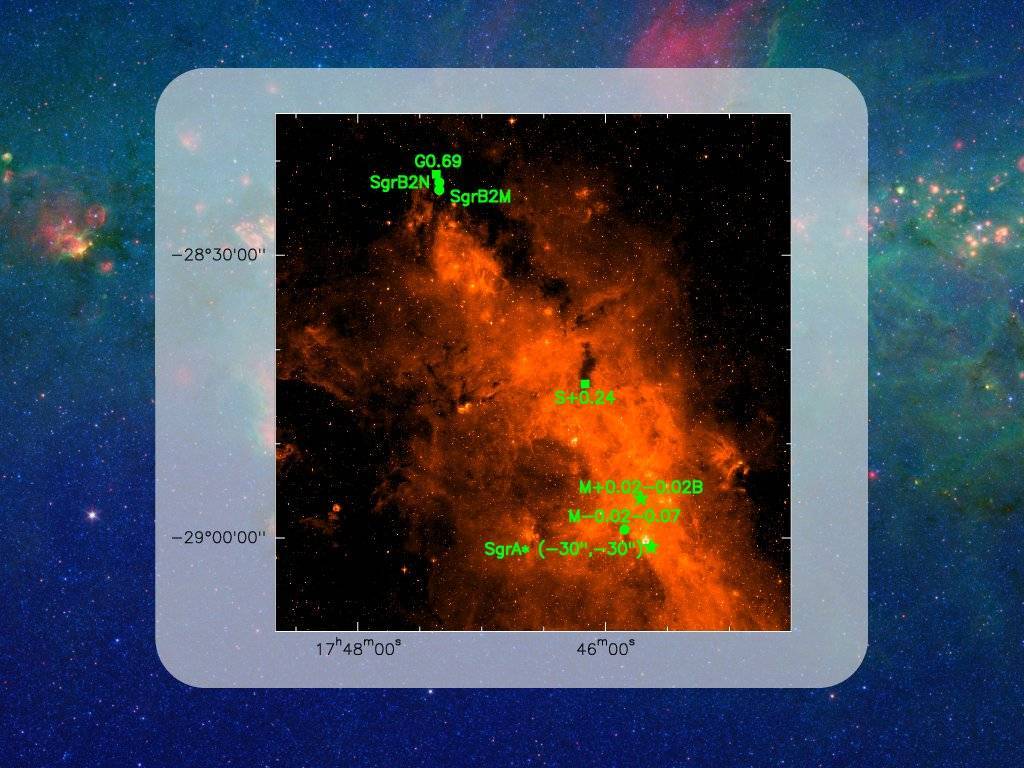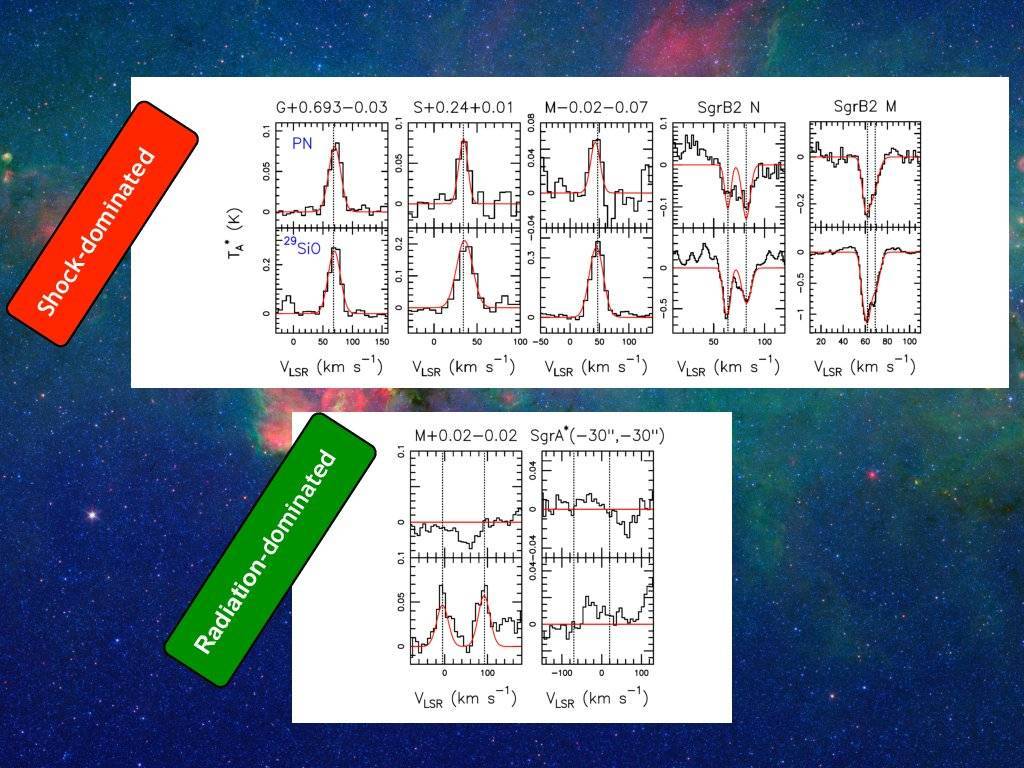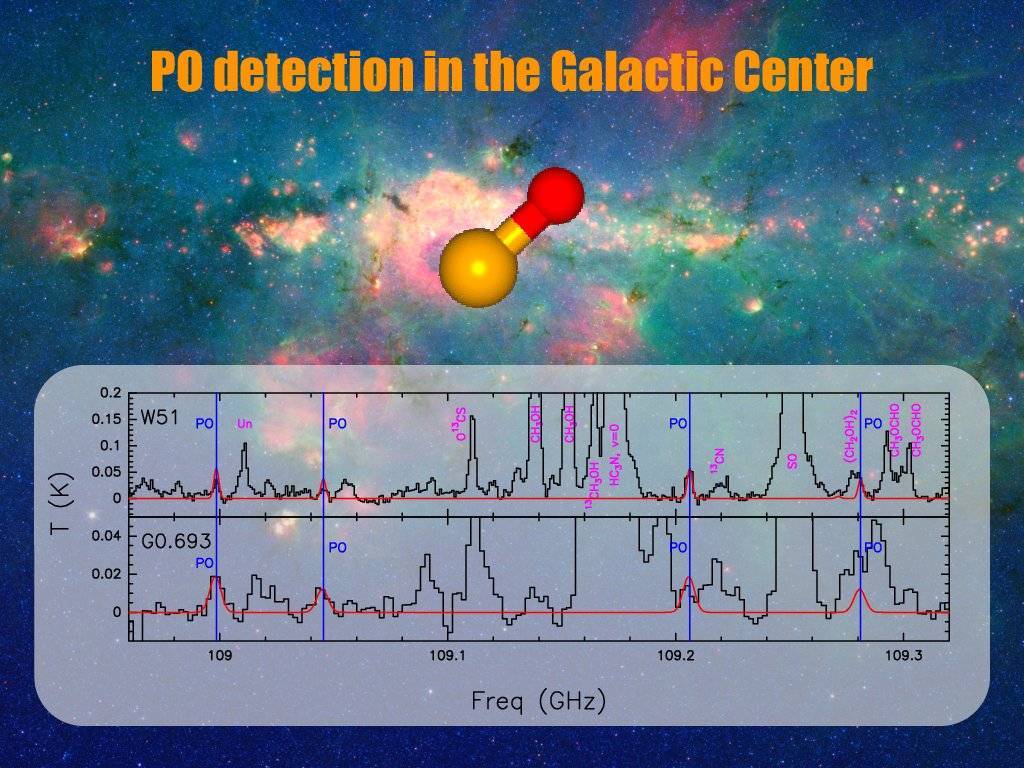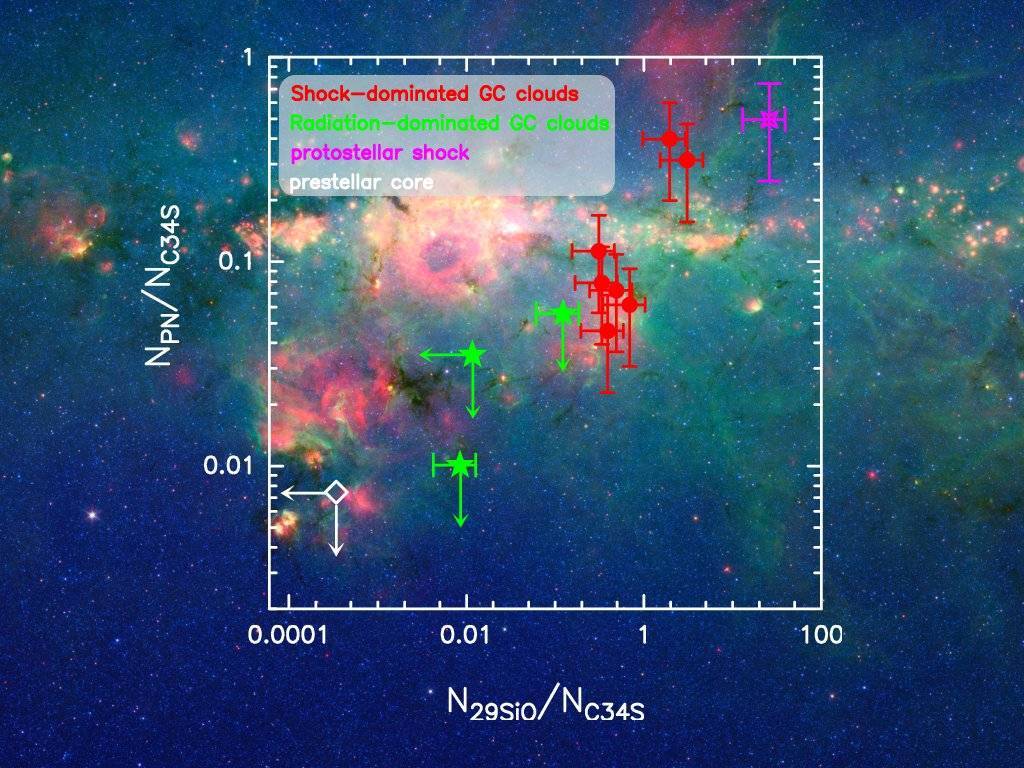Phosphorus-bearing molecules in the Galactic Center
Phosphorus (P) is one of the essential elements for life due to its central role in bio-chemical processes. Recent searches have shown that P-bearing molecules (in particular PN and PO) are present in star-forming regions, although their formation routes remain poorly understood. A group of researchers of the Arcetri Observatory, led by Victor Rivilla and including Francesco Fontani and Maria Teresa Beltran, has reported observations of PN and PO towards seven molecular clouds located in the Galactic Center, which are characterized by different types of chemistry. PN is detected in five out of seven sources, whose chemistry is thought to be shock-dominated. The two sources with PN non-detections correspond to clouds exposed to intense UV/X-rays/cosmic-ray radiation. PO is detected only towards the cloud G+0.693-0.03, with a PO/PN abundance ratio of 1.5. They conclude that P-bearing molecules likely form in shocked gas as a result of dust grain sputtering, while are destroyed by intense UV/X-ray/cosmic ray radiation.
Phosphorus (P) is essential for life because it plays a central role in the formation of macromolecules such as phospholipids (the structural components of cellular membranes) and the deoxyribonucleic acid (DNA, Macia et al. 1997). For decades PN remained as the only P-bearing species observed in these regions (Turner & Bally 1987; Ziurys 1987; Yamaguchi et al. 2011; Fontani et al. 2016), while PO has been discovered just recently in the surroundings of both high- and low-mass protostars (with PO/PN abundance ratios of 1-3; Rivilla et al. 2016; Lefloch et al. 2016).

Figure 1: Sample of Galactic Center clouds we have observed, overplotted on an Spitzer-IRAC 4 image.
The formation of P-bearing molecules is still poorly understood. Three routes have been proposed: (i) shock-induced desorption of P-bearing species (e.g. PH3) from dust grains and subsequent gas phase formation (Aota & Aikawa 2012; Lefloch et al. 2016); (ii) high-temperature gas-phase chemistry after the thermal desorption of PH3 from ices (Charnley & Millar 1994); and (iii) gas-phase formation of PN and PO during the cold collapse phase and subsequent thermal desorption (at temperatures 35 K) by protostellar heating (Rivilla et al. 2016). Due to the limited number of observations available, and the limited range of physical conditions of the observed regions with detected P-bearing molecules, the formation routes for PN and PO are strongly debated.

Figure 2: PN (2-1) and 29SiO (2-1) lines measured towards the Galactic Center clouds. The Local Thermodynamic Equilibrium best fits are shown with red lines. The PN molecule is only detected towards the sources dominated by shocks.
Victor Rivilla and collaborators have presented new observations of PN and PO towards seven regions spread across the Central Molecular Zone (CMZ) in the Galactic Center (GC) (see Figure 1). These sources are excellent laboratories to test the chemistry of P-bearing molecules since they show different physical properties (high kinetic temperatures, low dust temperatures and moderate densities) and chemistries dominated by either UV photons, cosmic-rays (CR), X-rays or shock waves. The selected sample includes two different types of sources: (i) Shock-dominated regions ; and (ii) Radiation dominated regions.
They have carried out observations at 3mm and 2mm using the radiotelescope IRAM 30m located at Pico Veleta (Granada, Spain). PN is detected towards five of the seven sources (see Figure 2). PO is detected only towards one of the sources, G+0.693-0.03 (see Figure 3), which is thought to be the richest source of O-bearing molecules in the Galactic Center. The derived PO/PN abundance ratio is 1.5, similar to values previously found in star-forming regions.

Figure 3: PO detection towards G+0.693-0.03 (lower panel) compared with the detection towards the hot molecular core W51 e1/e2 from Rivilla et al. (2016) (upper panel). The PO quadruplet is shown with vertical blue lines. Other molecular species are labeled in the upper panel. The Local Thermodynamic Equilibrium synthetic spectrum of PO in both sources is shown with red lines.
The regions where P-bearing species have been detected are clouds thought to be affected by shock waves, and rich in the well-known shock tracer 29SiO (see Figure 4). The two sources where no P-bearing molecules were detected are regions exposed to intense radiation, and exhibit lower abundances of 29SiO. We thus conclude that P-bearing species are formed in the gas phase after the shock-induced sputtering of the grain mantles, and that they are efficiently destroyed by the high cosmic-rays/X-rays/UV-photon radiation expected in the Galactic Center.

Figure 4: Column density ratios of PN and 29SiO with respect to C34S. The different type of sources are Shock-dominated GC clouds (red dots) and Radiation-dominated regions (green stars). The L1157-B1 shock (magenta open star) and the L1544 pre-stellar core (open diamond) have also been added. Arrows indicate 3 upper limits.
More info:
Contact: Víctor M. Rivilla, https://www.arcetri.astro.it/~rivilla/
Paper: “Phosphorous-bearing molecules in the Galactic Center”, accepted for publication in Monthly Notices of the Royal Astronomical Society Letters; https://arxiv.org/abs/1712.07006



